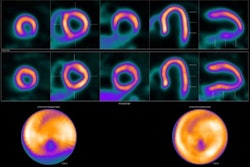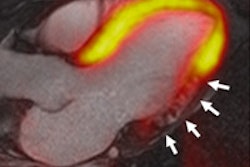PET myocardial perfusion imaging (MPI) with flurpiridaz F-18 is "safe and superior" to SPECT MPI with technetium-99m (Tc-99m) for image quality, interpretation, coronary artery disease (CAD) diagnosis, and patient tolerance of the tracer, according to a study published in the January 29 issue of the Journal of the American College of Cardiology.
In the phase II, multicenter trial, 99% of PET images with the myocardial perfusion tracer, which is being developed by Lantheus Medical Imaging, were rated as excellent or good, with a diagnostic certainty of 91%, the researchers found.
In addition, radiation doses from flurpiridaz F-18 injections were approximately two times lower than doses associated with traditional rest and stress tests under Tc-99m SPECT MPI protocols, according to the team led by Dr. Daniel Berman, chief of cardiac imaging and nuclear cardiology at the Cedars-Sinai Heart Institute (JACC, January 29, 2013, Vol. 61:4, pp. 469-477).
A total of 143 patients were enrolled: 107 men and 36 women, with a mean age of 62.5 years. All underwent SPECT MPI within 90 days before or 60 days after flurpiridaz F-18 PET MPI. Among patients who had invasive coronary angiography, the procedure was performed within 60 days of PET MPI.
Tc-99m agents were used for all SPECT scans, with 73 subjects given Tc-99m sestamibi and 35 given Tc-99m tetrofosmin in a one-day imaging protocol. There also were 10 participants who received Tc-99m sestamibi and six who were given Tc-99m tetrofosmin over a two-day protocol. Nineteen patients were evaluated with a rest thallium-201 and stress Tc-99m dual-isotope MPI protocol.
All PET scans were performed at rest and at stress; 140 participants were scanned with PET/CT systems and three were imaged with dedicated PET scanners. Imaging at rest began with flurpiridaz F-18 injection and was continuously acquired over 20 minutes. Stress dosing began 73.4 ± 12.1 minutes after rest studies in patients undergoing exercise stress and 52.9 ± 11.2 minutes after rest studies in patients receiving pharmacological stress testing.
Stress flurpiridaz F-18 PET MPI was performed with either exercise or adenosine stress (76 patients and 67 patients, respectively). For SPECT MPI, 44 patients underwent pharmacological stress with adenosine, seven received regadenoson, and 10 received dipyridamole.
Eleven patients were excluded from the study for a variety of reasons, including not having finished a SPECT MPI, PET at rest, or stress PET exam, leaving 132 patients who had both SPECT MPI and PET MPI studies available for image quality and diagnostic certainty analysis.
Adverse events
Among the 132 patients who qualified for the safety evaluation, two patients reported a total of three serious adverse events: dizziness, hypertension, and knee effusion. All incidents were determined to be unrelated to flurpiridaz F-18.
Sixty-one (43%) of the 143 patients reported 108 adverse events. Of those 61 individuals, 36 (59%) received pharmacological stress and reported a total of 75 adverse events. The other 25 patients (41%) had exercise stress and a total of 33 adverse events.
Berman and colleagues concluded that 100 (92%) of the 108 adverse events were not related to the PET tracer. The other eight incidents were judged as "possibly or probably" related to flurpiridaz F-18. All eight cases were considered mild or moderate in severity and resolved without complications, according to the authors.
Image quality
Of the 132 patients in the image quality analysis, PET image quality was considered excellent or good with flurpiridaz F-18 for 99% of the stress tests, compared with 89% for SPECT with Tc-99m. For rest imaging, image quality for PET with flurpiridaz F-18 was ruled excellent or good in 97% of the cases, compared with 66% with Tc-99m.
Excellent image quality alone was reported for stress images in 81% with flurpiridaz F-18, compared with 24% with Tc-99m. In rest studies, images were graded as excellent in 70% with flurpiridaz F-18, compared with 8% with Tc-99m.
Among the 132 patients, diagnostic certainty was considered definitely normal or definitely abnormal in 91% of patients with flurpiridaz F-18, compared with 71% of patients given Tc-99m. There was a threefold reduction in the number of patients in the probably normal and probably abnormal groups with flurpiridaz F-18, the authors noted.
CAD detection
Finally, among the 86 patients who underwent invasive coronary angiography, 52 had significant CAD. Using those results as a truth standard for coronary stenosis, PET's sensitivity was 79%, compared with 62% for SPECT. Specificity was 77% with PET and 74% with SPECT.
Given the findings, "this new tracer might significantly improve the assessment of patients with radionuclide MPI compared with the standard SPECT MPI methods." Berman and colleagues concluded.




















